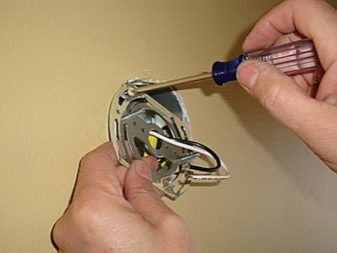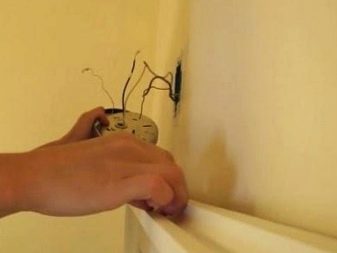Wall sconces for the bathroom

Wall lights for a while almost completely disappeared from our apartments - they have been replaced by spotlights, which have gained popularity due to their compactness. Today, wall sconces gradually regain their position, because, as time has shown, they have a lot of advantages over built-in lamps. In this article, we will talk about the features of wall-mounted light fixtures, about their varieties, as well as give some recommendations on the choice and installation of sconces for the bathroom.
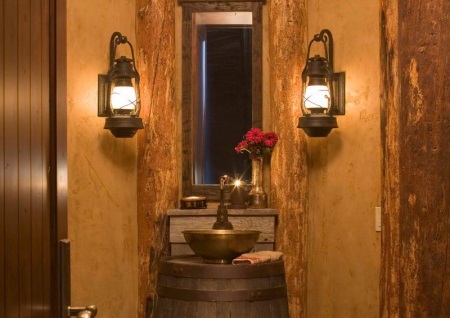
Pros
- In contrast to the now popular recessed lights, wall sconces illuminate a sufficiently large amount of space. Spotlights are designed to illuminate individual small areas of the bathroom, and a pair of sconces can illuminate the entire room.
- For sconces the height of the ceiling does not matter, while the built-in lamps and even conventional chandeliers require sufficiently high ceilings.
- With wall sconces can be organized by highlighting certain areas or elements of the interior of the bathroom.
- Wall sconces also perform a decorative function. In contrast to the rather monotonous built-in lights, sconces are available in a variety of variations. In stores there is a wide variety of choices of lamps of this model, many of which can become a highlight of the interior of the bathroom.
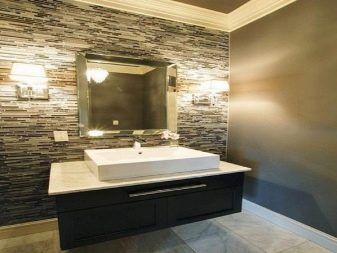

Cons
- For lighting fixtures installed in the bathroom, it is required to equip concealed electrical wiring. And, if the wires for built-in ceiling lights are hidden behind a suspended or plasterboard ceiling, then for the installation of sconces, the wiring will have to be hidden inside the wall. To do this, you need to punch small channels in the wall, then put in these strokes electrical cables and seal them with cement again.
- In the bathroom there is always a high level of humidity. Humid air negatively affects the condition of electrical appliances installed in the room. The body of recessed luminaires is reliably protected from external influences by a second ceiling, while the body of the wall luminaire inevitably comes into contact with moist air.
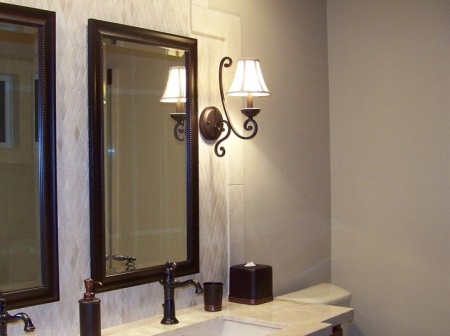
Requirements
Requirements for wall lights are primarily due to the "climatic" characteristics of the room in which they are used. The bathroom is characterized by high humidity, frequent temperature fluctuations, exposure to steam and water splashes, the appearance of condensation. Therefore, special attention is paid to the material of sconces intended for installation in the bathroom. It must meet two basic requirements:
- be water-resistant;
- not to be deformed as a result of temperature changes.
Wall lights for the bathroom are most often made of plastic, glass and other resistant materials. The metal parts of the product should be protected against corrosion, and the wooden parts should be treated with substances that prevent rotting.
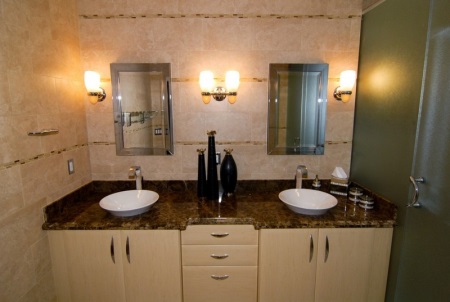
Moisture resistance
So, the main quality of bathroom sconces is the ability to work in contact with water, that is, the presence of protection against moisture. The degree of this protection is indicated on the packaging of the product or in the instructions to it. It is denoted by the abbreviation IP and two numbers. The first number characterizes the degree of protection against ingress of foreign bodies, and the second - moisture protection.
There are a total of 9 degrees of protection of lighting fixtures from moisture - from 0 to 8. Luminaires labeled IPX0 will not withstand the slightest contact with moisture, while light fixtures labeled IPX8 can be used underwater, at a depth of several meters.
For use in the bathroom, sconces whose degree of moisture protection ranges from 4 to 6 are suitable.
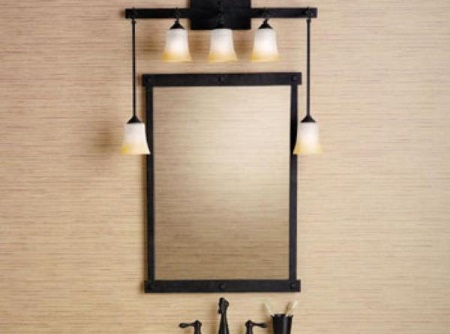
Types .
Depending on the type of plafond, a distinction is made:
- sconces with diffused light - they are also called general lighting fixtures; The shape of the plafond in these light fixtures is such that the angle of luminous flux is 360 degrees, so that the light is scattered throughout the room, rather than concentrated in a particular place.
- Spotlighting - used to illuminate selected areas or objects in the interior of the bathroom; The shape of the lampshade limits the light stream and allows you to give it a certain direction.
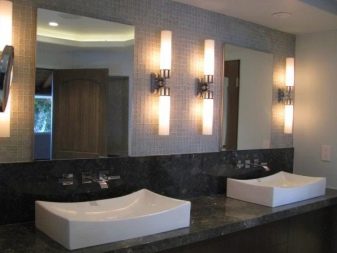
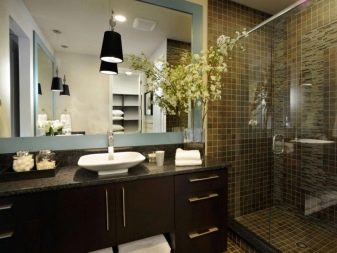
According to the type of location are distinguished:
- horizontal sconces - wall lights, which are usually installed above or below some object of the interior and provide its illumination;
- Vertical sconces - the traditional models of wall lamps, with open-top lamp shades, serving to illuminate the entire room or a specific area.

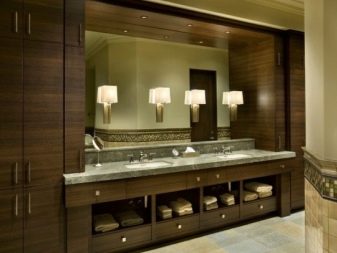
Styles
The wall lamp is a classic interior object, which, meanwhile, is used to decorate bathrooms in a variety of styles.
Classic
Classic interior is characterized by simple and elegant forms combined with expensive materials. Classic style wall lamps traditionally have decorative elements of rare wood, metal with gold or bronze sputtering, crystal. Classic wall lamps are often made in the form of candlesticks or candelabra.
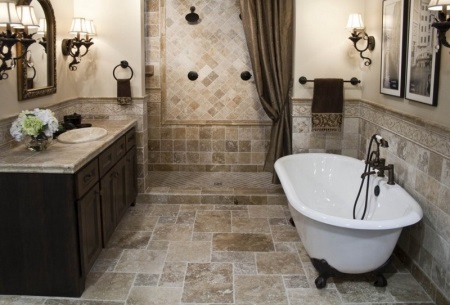
Antique
The antique style has always been considered a model of harmony and beauty. Antique style interior items are quite massive, but at the same time, laconic. Chandeliers in the antique style remind us of ancient Greek sculptures or ceramics. Often such products are decorated with simple plant ornaments.
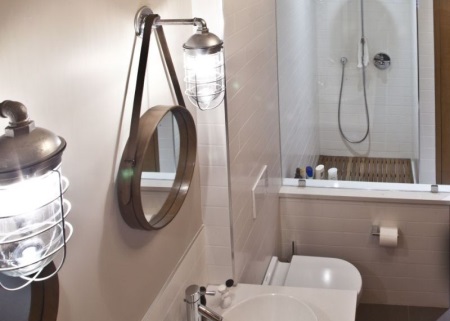
Baroque
Baroque is a very "decorative" style, which loves a large number of decorations and piling of details. Some Baroque accessories will seem defiantly opulent and pretentious, but in combination with a restrained interior, they look just great.
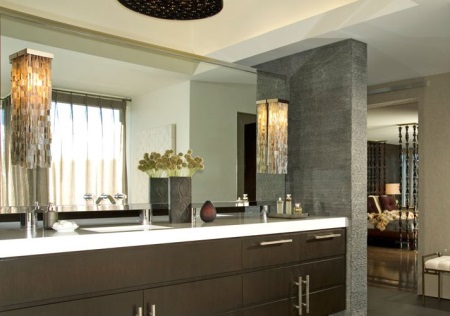
Modern
Modern is a style that combines elegance and bold experimentation with form. For sconces in the Art Nouveau style used expensive and beautiful materials: metal, colored glass, semi-precious stones. The lamps made of stained glass are a characteristic feature of wall lights in the modern style.
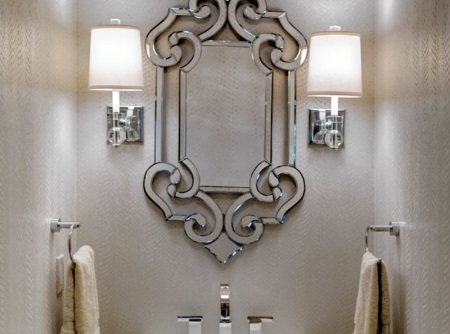
High-tech
High-tech style does not tolerate decorative excesses, and focuses on the functionality of the interior. Wall fixtures in high-tech style have a simple design and strict, geometric shapes. For the manufacture of sconces are mainly used, chrome metal and impact-resistant glass.
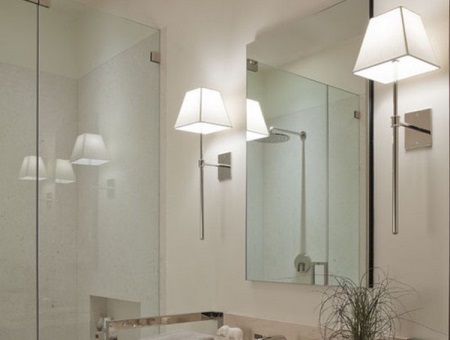
Pop Art
Pop art is one of the most striking and memorable styles in the history of arts and crafts and design. Wall lights in the pop art style are characterized by rich, pure colors and unusual shapes of the lamps. It is possible to use images of animals and people stylized as comic strips. The main material of manufacture is plastic.
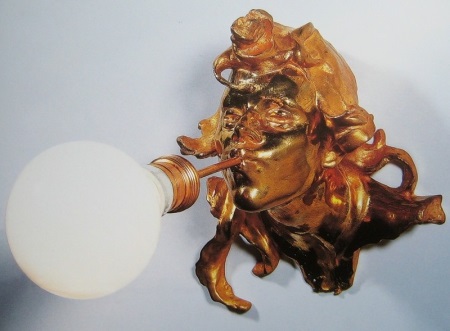
Location
Above the mirror.
The area near the mirror is the most popular place to place wall lights. Above the mirror it is most convenient to place horizontal sconces of directional light. You only need to direct the light flux so that it does not hit the eyes, and illuminated the work area. Remember that the light that falls from above, emphasizes all the defects of the skin of the face.


On the side of the mirror
By placing two wall lights on either side of the mirror, you can create a complete, symmetrical composition. If you install only one sconce on the side of the mirror, the lighting will be uneven, plus there will inevitably be shadows that will interfere with the application of makeup or shaving.
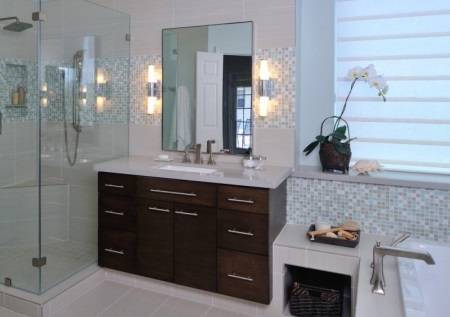
Opposite the mirror
Sconces, placed on the wall opposite the mirror, are assessed by interior designers ambiguously. On the one hand, the light reflected in the mirror visually increases the area of the bathroom, and makes the room lighter. On the other hand, daily cosmetic and hygienic procedures will interfere with the glare that falls directly into the eyes.
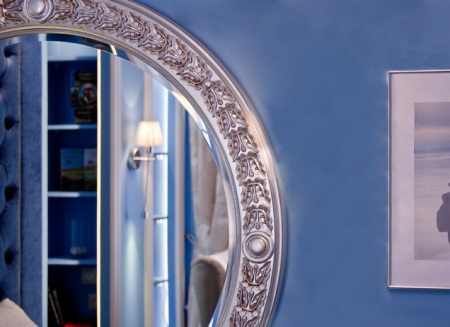
Design
Choosing sconces in the bathroom, you need to pay attention not only to the technical characteristics of the lighting fixture, but also to the aesthetic component.
- The design of the wall lamp must be in harmony with the rest of the room. This does not mean that you can not allow a mixture of styles, but even for eclectic interior should be carefully selected furniture and accessories.
- In addition to the style of the sconce, you should also take into account its size. The dimensions of the lamp should be proportional to the size of the room and the mirror, near which it will be installed.
- If a sconce is only an additional source of light in the bathroom, it should be matched with the main light fixture (usually a ceiling light fixture). It is good if they will match in style and harmonize in color scheme. The ideal option is to buy all light fixtures from the same collection.
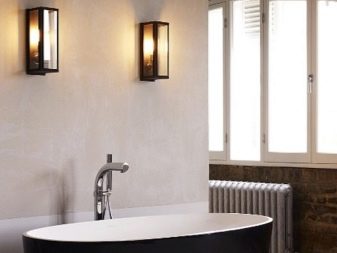
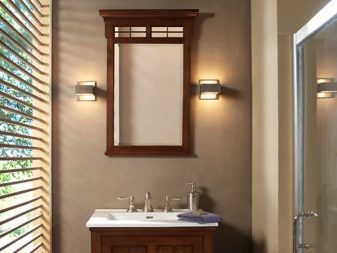
Suggestions for choosing
To summarize the information about wall lights can be formulated by formulating a few tips regarding the choice of sconces for the bathroom.
- Fixtures that are purchased for use in a room with a high level of humidity, should be made of materials that are resistant to corrosion and decay.
- Be sure to pay attention to the marking that informs about the degree of moisture resistance of your chosen sconces. The optimal degree of protection for wall lights in the bathroom is from 4 to 6.
- Determine in advance the future location of the lamp. If you are going to place a light fixture above a mirror or to illuminate certain elements of the furnishings, then choose a horizontal sconce. For all other cases vertical sconces will do.
- In the stores of lighting fixtures you will surely come across a huge variety of wall lamps. When selecting, proceed from the overall style design of the bathroom, so that the new wall sconces fit harmoniously into the existing interior.
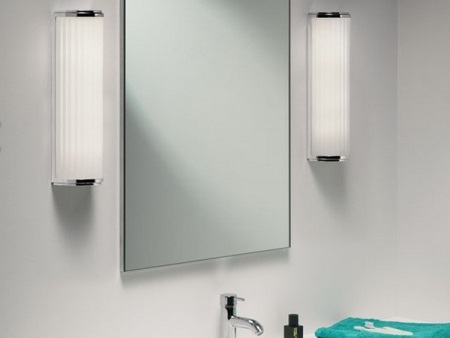
Installation
Installing a wall lamp in the bathroom is not much different from the installation of sconces in any other room of the house. The only difficulty that may arise - it is drilling holes in the ceramic tile. But anyone who has minimal experience in construction and repair work and owns the necessary equipment, will cope with this task without difficulty.
- First, it is necessary to draw a marking on the wall, according to which we will drill holes. To do this, we put the bracket, on which the lamp is mounted, on the wall and mark the places where the mounting holes will be located.
- Armed with a hammer or drill, make mounting holes in the wall. You must first turn off the power on the tool to avoid damaging the ceramic tile. You can drill on concrete with the hammer already turned on.
- Install the bracket in place, using a set of fasteners that come with the product.
- Next, we perform the connection of the lighting fixture to the electrical wiring. To do this, simply connect the wires coming out of the wall and those that are in the body of the device.
- Now you can screw in the bulb and install the plafond in place.
